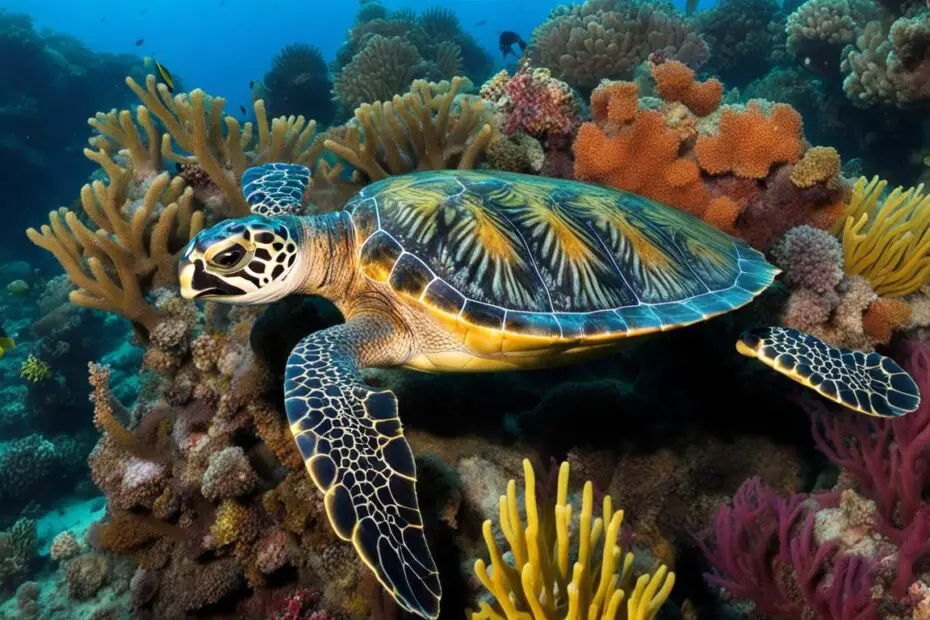Welcome to our article on the critically endangered hawksbill turtle. With only around 8,000 nesting females left globally, the hawksbill turtle is one of the most endangered species of sea turtles on Earth. In this article, we will explore the causes behind their endangered status and the vital conservation efforts being made to protect them.
Key Takeaways:
- Hawksbill turtles are classified as Critically Endangered by the IUCN.
- Threats to hawksbill turtles include illegal trade, habitat loss, pollution, climate change, and accidental capture in fishing gear.
- They primarily inhabit coral reefs, rocky areas, lagoons, and shallow coastal areas.
- The illegal wildlife trade for their tortoiseshell remains a significant threat to hawksbill turtle populations.
- Conservation efforts and protective legislation are critical for their survival.
Hawksbill Turtle Population and Habitat
Hawksbill turtles, scientifically known as Eretmochelys imbricata, are predominantly found in the central Atlantic and Indo-Pacific regions. These remarkable creatures can grow to a length of 70-90cm and weigh between 45 and 70kg. Hawksbills undergo a remarkable transition in their habitat choices as they progress through different life stages. During their early years, they inhabit open ocean environments. However, once they reach a length of approximately 20-25cm, they migrate to coastal areas for foraging.
Hawksbill turtles primarily dwell in a variety of ecosystems, with coral reefs being one of their preferred habitats. These reefs provide a rich array of resources, including the sponges and algae that form the turtles’ main diet. Hawksbills can navigate through the intricate structures of coral reefs with remarkable agility. In addition to coral reefs, they also inhabit rocky areas, lagoons, and shallow coastal regions that offer abundant sources of food and shelter.
“The vibrant coral reefs form an integral part of the hawksbill turtle habitat, offering them a diverse range of resources crucial for their survival.” – Marine Biologist Emily Carlton
It is worth noting that coral reefs play a crucial role in the life cycle of hawksbill turtles. These magnificent creatures rely on the reefs for food, protection, and nesting sites. However, the health and survival of coral reefs are increasingly threatened by factors such as climate change, pollution, and destructive fishing practices. The decline of coral reefs poses a significant risk to hawksbill turtle populations, highlighting the urgent need for conservation and preservation efforts.
Below is a table summarizing the key characteristics of hawksbill turtles:
| Characteristic | Details |
|---|---|
| Average Length | 70-90cm |
| Average Weight | 45-70kg |
| Main Habitat | Coral reefs, rocky areas, lagoons, shallow coastal regions |
| Preferred Diet | Sponges, algae, other marine invertebrates |
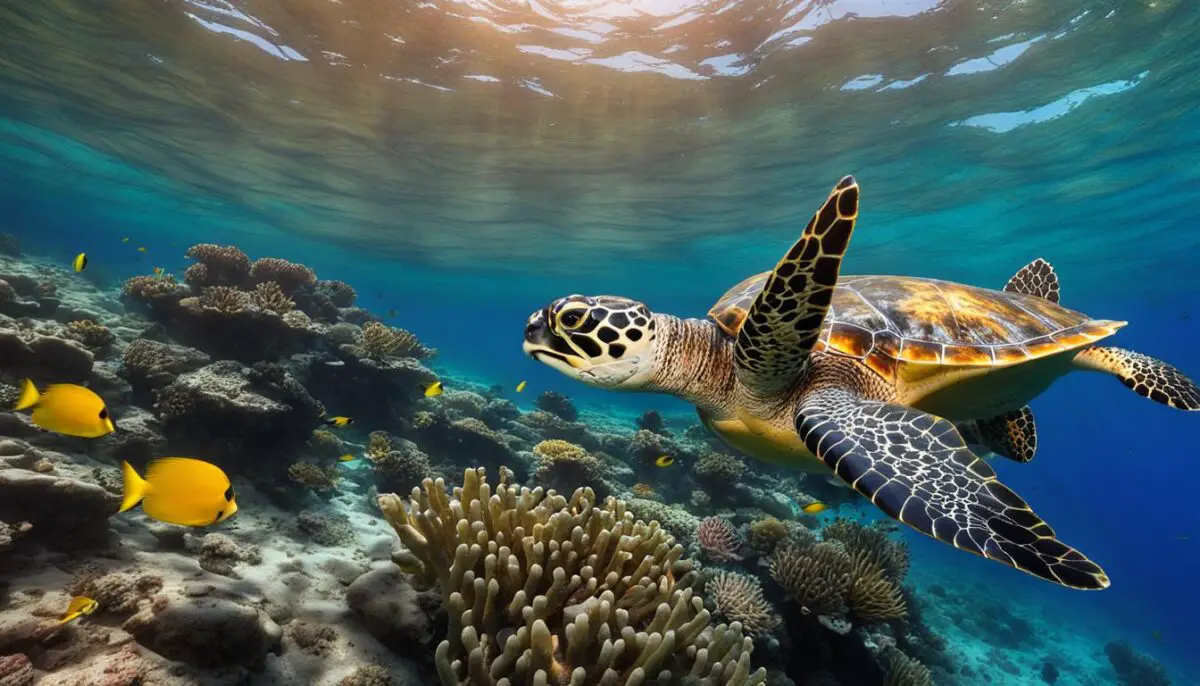
Threats to Hawksbill Turtles
The hawksbill turtles face numerous threats to their survival. These majestic creatures are targeted for various reasons, leading to a rapid decline in their population.
Illegal Trade and Exploitation
One of the most significant threats to hawksbill turtles is illegal trade. These turtles are hunted for their beautiful carapace, which is then used in the creation of jewelry and other decorative items. Despite international bans on the trade of hawksbill turtle products, the demand for their shells remains high in certain regions.
Consumption of Meat and Eggs
In some cultures, the consumption of hawksbill turtle meat and eggs continues, even though it poses health risks. This unsustainable practice not only depletes the population, but it also disrupts the natural balance of marine ecosystems.
Accidental Capture in Fishing Gear
Hawksbill turtles often fall victim to accidental capture in fishing gear, such as nets and lines. This widespread issue is a major threat to their survival, as it leads to injury, suffocation, or drowning. Bycatch reduction measures and the implementation of turtle excluder devices are crucial in minimizing this threat.
Marine Pollution and Plastic Debris
Marine pollution, including plastic debris, poses a severe threat to hawksbill turtles. These creatures often mistake floating plastic for food, which can lead to blockages in their digestive system and eventual death. Additionally, pollution harms the delicate coral reef ecosystems that hawksbills rely on for food and shelter.
Habitat Loss due to Coastal Development
The rapid pace of coastal development has resulted in habitat loss for hawksbill turtles. Destruction of nesting beaches and coastal areas disrupts their natural breeding and foraging habitats. Coastal development also contributes to beach erosion, which further diminishes suitable nesting sites for these turtles.
“The survival of hawksbill turtles is threatened by illegal trade, pollution, accidental capture, and habitat loss. Urgent action is needed to protect these iconic creatures and ensure their conservation for future generations.”
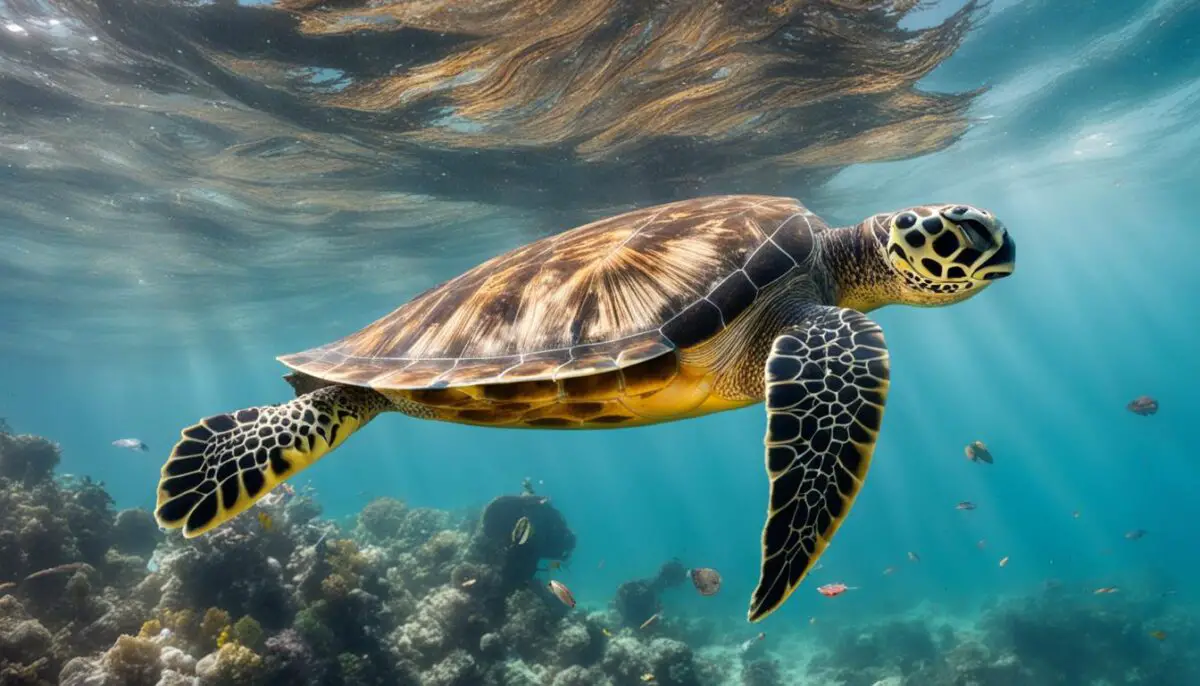
| Threats | Impact |
|---|---|
| Illegal Trade | Depletion of population, disruption of ecosystems |
| Consumption of Meat and Eggs | Unsustainable practices, disturbance of marine ecosystems |
| Accidental Capture in Fishing Gear | Injury, suffocation, or drowning |
| Marine Pollution and Plastic Debris | Ingestion leading to health issues and death |
| Habitat Loss due to Coastal Development | Disruption of breeding and foraging habitats |
Impacts of the Wildlife Trade
The hawksbill turtle, known for its stunning tortoiseshell, is unfortunately a prime target of the illegal wildlife trade. Despite bans on domestic and international trade, the tortoiseshell market continues to thrive in certain regions, posing a severe threat to hawksbill turtle populations.
Millions of hawksbill turtles have been mercilessly killed solely for their exquisite shells, which are highly sought after for the creation of jewelry and other decorative items. The demand for tortoiseshell products in Europe, the United States, and Asia has significantly contributed to the decline of these beautiful sea creatures.
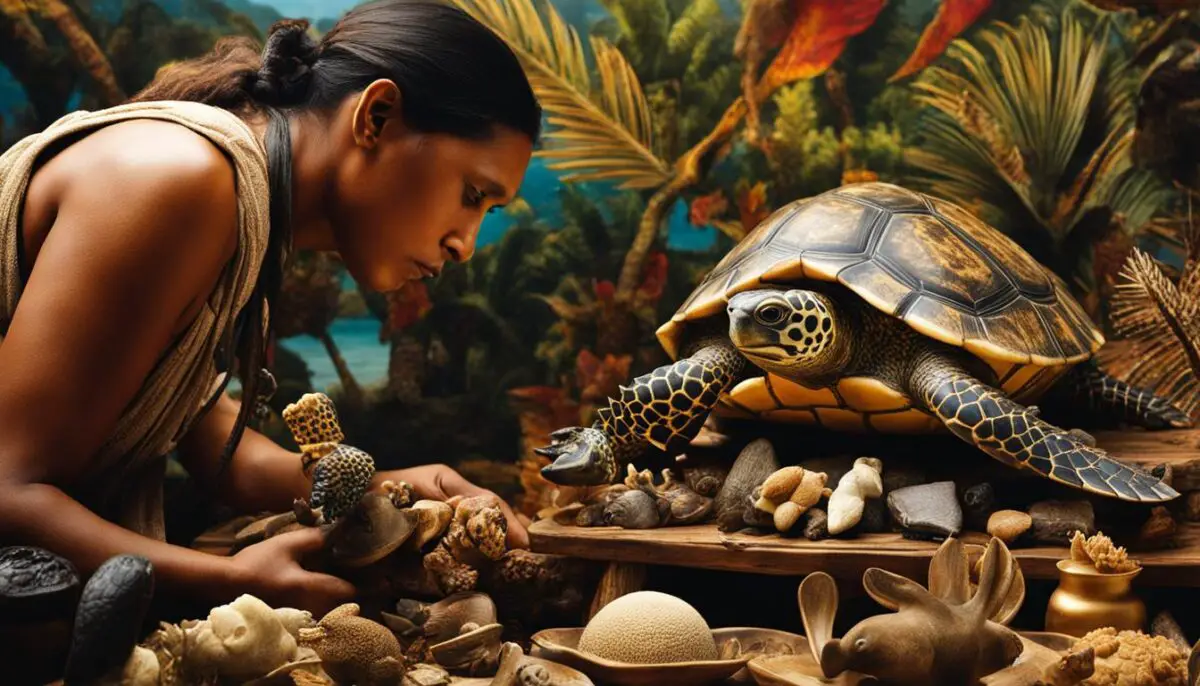
In the face of trade bans and conservation efforts, the illicit harpooning of hawksbill turtles for their tortoiseshell persists. These turtles endure great suffering solely for the purpose of satisfying the tortoiseshell market.
“The illegal wildlife trade poses a grave threat to hawksbill turtles and their long-term survival. The demand for tortoiseshell products fuels the relentless hunting of these beautiful creatures, pushing them further towards extinction.”
This cruel trade not only results in the loss of countless hawksbill turtle lives but also disrupts the delicate balance of marine ecosystems. As these turtles play a crucial role in maintaining healthy coral reef systems, their declining populations have far-reaching consequences.
The hawksbill turtle trade and the tortoiseshell market must be urgently addressed through strengthened enforcement of trade regulations, public education, and sustainable alternatives for tortoiseshell products. By raising awareness and changing consumer behavior, we can help safeguard the future of these magnificent creatures and protect the delicate marine environments they call home.
Importance of Conservation Efforts
Conservation efforts play a crucial role in protecting hawksbill turtles and ensuring their survival despite their endangered status. With the increasing public interest and awareness surrounding sea turtles, including hawksbills, there has been a growing focus on implementing protective measures.
One of the key aspects of hawksbill turtle conservation is the development of legislation and the establishment of nesting and foraging sanctuaries. These protected areas provide a safe environment for hawksbills to nest and find food, allowing them to thrive and contribute to the recovery of their populations.
Research and monitoring programs also play a vital role in conservation efforts. By gathering valuable information about hawksbill turtle behavior, migration patterns, and population dynamics, scientists can make informed decisions and develop effective conservation strategies.
Conservation is a race against time. By protecting habitat, reducing bycatch, and addressing other threats, we can give these magnificent creatures a fighting chance for survival.
Furthermore, international treaties and national laws have been put in place to regulate marine activities and minimize human impacts on hawksbill turtles. These measures aim to reduce bycatch, which is the accidental capture of turtles in fishing gear, and promote sustainable fishing practices that have a reduced impact on turtle populations.
Table: Conservation Initiatives for Hawksbill Turtles
| Initiative | Description |
|---|---|
| Nesting and Foraging Sanctuaries | Designated areas where hawksbill turtles can nest and find food without disturbance. |
| Research and Monitoring Programs | Data collection and analysis to support conservation efforts and inform decision-making. |
| International Treaties | Agreements between countries to protect hawksbill turtles and their habitats. |
| National Laws | Legislation enacted by individual countries to regulate marine activities and reduce threats. |
| Sustainable Fishing Practices | Methods that minimize the impact of fishing on hawksbill turtle populations. |
By combining these conservation efforts, we can make significant strides in protecting hawksbill turtles and improving their conservation status. It is essential that we continue to prioritize their protection and work towards a sustainable future for these incredible creatures.
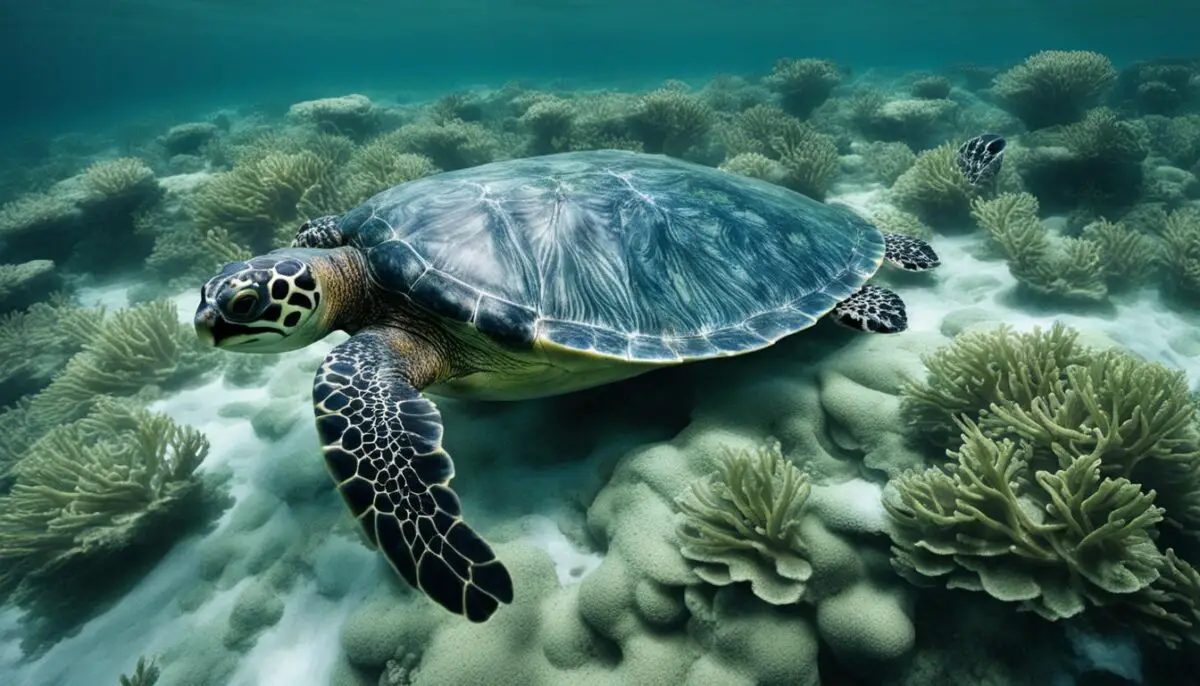
Human Impact on Nesting Sites
Coastal development poses a significant threat to hawksbill turtle nesting sites. The construction of buildings and infrastructure along coastlines can lead to erosion, resulting in the loss of vital nesting habitats for these endangered turtles.
Additionally, human activities such as the placement of beach furniture, light pollution, and tourist interactions can disturb nesting females and overall impact nesting success. Artificial lights on nesting beaches, for example, can disorientate turtles, leading them away from the sea and increasing their vulnerability to predation and dehydration.
To ensure the conservation of hawksbill turtles, it is crucial to take proactive measures in protecting nesting beaches from the negative consequences of coastal development and minimizing human disturbance. This can be achieved through the implementation of responsible coastal management practices and the establishment of protected nesting areas.
“Protecting nesting beaches is crucial for the survival of hawksbill turtles. We must prioritize the preservation of these habitats to ensure the continuation of this magnificent species.”
Conclusion
The hawksbill turtle, a critically endangered species, is facing numerous threats to its survival. Illegal trade, habitat loss, pollution, and climate change are all contributing to the decline of hawksbill turtle populations. However, there is hope for these magnificent creatures.
Increased public awareness, conservation efforts, and research are key factors in protecting hawksbill turtles. It is crucial that we prioritize their conservation and work towards a sustainable future. Protecting nesting sites, reducing bycatch, and addressing climate change are essential for the long-term survival of hawksbill turtles.
With their stunning beauty and unique characteristics, hawksbill turtles hold a special place in our natural world. Their critical role in maintaining the health of coral reef ecosystems cannot be understated. By taking action now, we can ensure the preservation of hawksbill turtles for generations to come.
FAQ
Why are hawksbill turtles endangered?
Hawksbill turtles are endangered due to threats such as illegal trade, habitat loss, pollution, climate change, and accidental capture in fishing gear.
Where do hawksbill turtles live?
Hawksbill turtles are found in the central Atlantic and Indo-Pacific regions. They primarily inhabit coral reefs, rocky areas, lagoons, and shallow coastal areas.
What are the threats to hawksbill turtles?
Hawksbill turtles face threats such as illegal trade, habitat loss, pollution, climate change, and accidental capture in fishing gear.
What is the impact of the wildlife trade on hawksbill turtles?
The wildlife trade, particularly for their tortoiseshell, has contributed to the decline of hawksbill turtle populations. The demand for their shells in jewelry and other decorative items remains a threat in certain regions.
Why is conservation important for hawksbill turtles?
Conservation efforts are critical for the survival of hawksbill turtles. Despite their endangered status, there is hope for their populations. Protective legislation, nesting and foraging sanctuaries, research, and monitoring programs are all aimed at protecting hawksbill turtles.
How does climate change affect hawksbill turtles?
Climate change poses a significant threat to hawksbill turtles and their primary foraging habitat, coral reefs. Rising temperatures and coral bleaching events impact both the availability of food for hawksbills and their overall vulnerability to other threats.
What human activities impact hawksbill turtle nesting sites?
Coastal development can lead to the loss of hawksbill turtle nesting sites due to erosion caused by development. Beach furniture, light pollution, and tourist activities can disturb nesting females and impact nesting success.
What is the conservation status of hawksbill turtles?
Hawksbill turtles are classified as Critically Endangered by the IUCN. With only approximately 8,000 nesting females left globally, they are believed to be one of the most endangered species of sea turtle.
